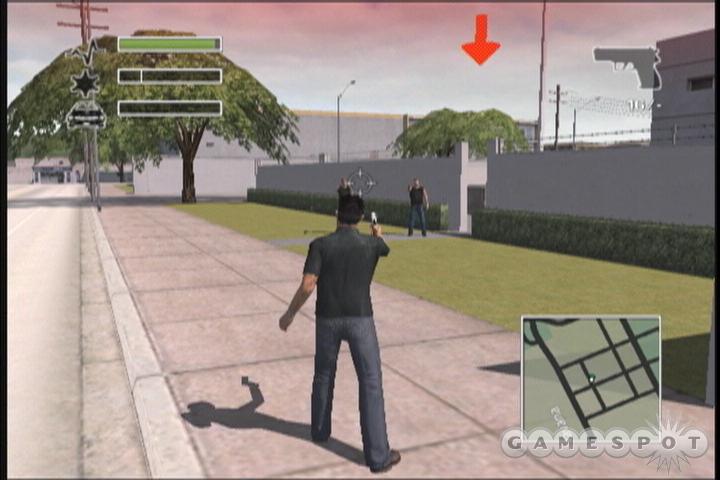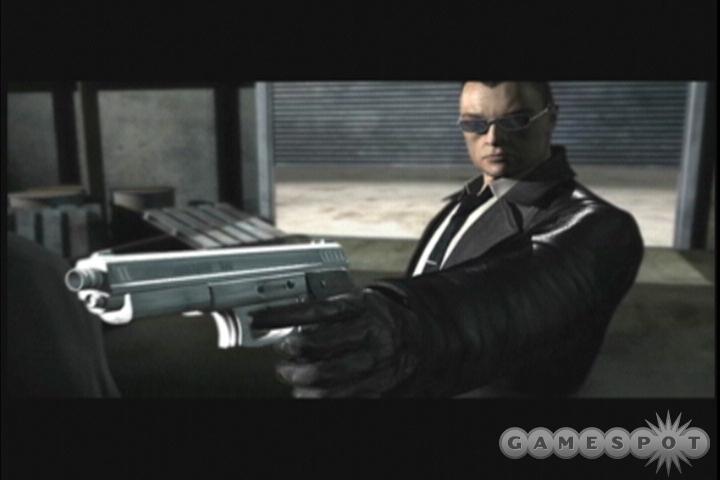In the past few years, the open-ended crime simulation subgenre has exploded, due in no small part to the success of Grand Theft Auto III. But back when GTA was still just a 2D game in an increasingly 3D world, Reflections released a PlayStation game called Driver. While it didn't offer the sort of weapon-based, on-foot thrills that you'd expect from a modern game, Driver sort of set the tone for what was to follow by giving you a fairly open city with a lot of potential for, well...driving. But times have changed. Driver 2, which came out in 2000, went ahead and added some carjacking and other out-of-car experiences. Today's popular crime games mix free-form driving sequences with a healthy dose of on-foot action complete with a whole lot of gunplay and gritty subject matter. And Reflections has put together such a game in the third installment in the Driver series, which once again puts you in the shoes of Tanner, an undercover FBI agent with a lead foot. Unfortunately, a bevy of technical problems make portions of the game feel sloppy and unfinished, such that even diehard fans of the series will have a hard time liking Driver 3.

This time around, Tanner is trying to infiltrate a Miami-based car thief ring, which is working to steal 40 exotic cars and ship them out of Miami. Part of the game's story involves finding out who the thieves in the car ring are working for, where the cars are going, and who's double-crossing whom. You'll start out in Miami, eventually make your way to Nice for some French car chases, and you'll also spend some time in Istanbul. The story is mostly told via prerendered cutscenes that fall somewhere between a music video and a movie in terms of style and inspiration. Generally speaking, the cutscenes look pretty good, even though they are encoded at lower bitrates that show off some unsightly artifacting. In fact, the cutscenes are probably the best part about Driver 3.
Despite featuring three large cities to drive in, Driver 3's main mode is a linear, mission-based game that sends you on mission after mission until you've unraveled the game's story. Each mission has clear-cut objectives, like chasing after a guy who double-crossed your gang, stealing three cars and driving them into the back of a moving truck before the truck gets to its destination, or driving around on an enemy's turf and busting up the place by crashing through exploding barrels and other objects. At the end of every mission, you're given the option to save and then you can continue on to the next mission. The missions tend to vary from city to city, but the lackluster gameplay really prevents many of the missions from being much fun.

For a game called "Driver," you may be surprised to find yourself spending quite a lot of time out of your car, and that's where the first significant gameplay problem comes to light: most of the on-foot action is weak. Your control over Tanner is stiff, at best. As you'd expect, the left stick strafes and the right stick steers, as in a typical shooter. You can fire weapons, you can halfheartedly jump, and you can duck to perform some pretty lame rolls. While you probably wouldn't expect much more from a gruff undercover guy like Tanner, all of his movements look stilted and jittery, and the gunplay--despite giving you access to a number of different pistols, submachine guns, an assault rifle, a shotgun, and a grenade launcher--is decidedly underwhelming. The combat in the game isn't tense at all, and it mostly consists of you running up to enemies and blasting them...before they blast back, if possible. However, the game is pretty liberal with the health packs, so you can certainly trade shots with most of your foes without worrying too much. Since most of the game's artificial intelligence is incompetent, you can usually get the drop on the bad guys.
The game's driving portions are better than the on-foot stuff, but not all that much better. You're given a map of the city with a pretty clear indication of where to go, and you're usually in a hurry, so there isn't much time to explore the game's cities in the story mode. The physics behind the driving appear to be designed to give you that '70s-cop-show-car-chase feel, in that everything has been exaggerated. Even the slightest turn around a corner is a tire-screeching, sliding-out affair. Getting slammed hard by a cop car might send you flying into the air, causing you to barrel roll a half-dozen times before crashing back to Earth.
The problem is that the driving isn't especially fun, as you constantly feel more like you're fighting to stay in control of the car than skillfully outmaneuvering your pursuers. Sometimes you'll hit a ramp and land just fine; and sometimes you'll land differently and roll your car, forcing you to retry a mission. There are also some discrepancies between what you can and can't drive through. Some objects will let you drive right through them, while others will stop all of your forward progress with a loud, damaging crash. What's more, it's even occasionally possible to crash into objects like streetlights or trees, essentially making it look like the streetlight or other object is growing out of the middle of your car. This causes your car to become completely stuck.

The driving AI isn't much better than the on-foot AI, either. Police chases--which happen more often in the game's additional modes than they do in the main story--are especially ridiculous. Cops basically aren't smart enough to get out of their cars and shoot at you unless they can get close enough to you. So, for example, if you were to jump over a guardrail and swim out into the water surrounding Miami, a cop that's pursuing you would simply drive his car into that guardrail, back up, and then drive into that guardrail over and over again. If you can get the cops to get out of their cars, they aren't much smarter. We were able to duck next to the passenger side of a cop car, which caused the cop to get out of the driver's side and simply start taking shots at us with his shotgun. But since his car was in the way, the cop was pumping round after round into the side of his car until we decided to move. Cars in Driver 3 don't explode unless they are repeatedly shot in the engine.
Aside from the main story mode, which will take the average player around 10 to 12 hours to complete, the game also has a few secondary modes, though they really don't add much to the experience. You can opt to simply drive around a city in the "take a ride" mode. There are also some driving games to play, such as checkpoint races, a survival mode that forces you to last as long as possible against the game's dopey, crash-happy police AI, and so on. You can also save replays and edit them by inserting different camera angles, slow-motion effects, and so forth. Furthermore, if you wish, you can also share these replays via Xbox Live.
A big part of what makes Driver 3 so mediocre is a series of technical, graphical glitches that make the game look like an absolute mess. For starters, the game is very, very aliased for an Xbox game. Everything from Tanner's legs to the sides of car models are incredibly jaggy. Playing in the game's 480p video mode just makes this problem stick out even more. Also, the game has a great deal of nasty pop-up. What makes it so much nastier than your average pop-up or draw-in is that the distance at which items appear seems to vary at random. On average, cars tend to appear when they're around the equivalent of 80 feet from your position, which when you're cruising along at full speed, is just enough time to react. Unfortunately, sometimes cars won't show up until they're even closer. This can be catastrophically frustrating, as one crash can often be the difference between completing a mission and having to replay it. The problem isn't limited to cars, either. Ramps also decide to appear with the same randomness. For example, if you need to get up onto a rooftop to complete an objective, you won't be able to see the ramp you need to jump from until you're almost on top of it, which is something that goes beyond the realm of a mere graphics problem and begins to seriously impact the gameplay as well.
The game's textures also don't load in properly, either. The game uses level-of-detail effects that draw low-resolution textures for faraway items. Since you can't see the objects very well at a distance, the low-resolution textures aren't really noticeable, and in theory, by the time you get close enough to notice, the game automatically replaces that ugly texture with a much nicer-looking one. But in Driver 3, the game sometimes can't load in those textures fast enough. In one instance, we got stuck staring at the side of a building with a texture on it that looked like it belonged in a first-generation Nintendo 64 game before it finally caught up and replaced the texture with the proper one.
The graphical glitches don't stop there. Textures and objects also tend to shimmer and tear apart at random. The game's frame rate jumps around more than it should. And in a few cases, the motion blur effect seemed to simply stop working properly, causing random streaks of light to flash in the game's night sky. Once you get past all of that, the game's car models are pretty good and when they explode, they explode pretty well. But compared to other similar Xbox games, Driver 3's graphics fall short.

The sound side of things is pretty underwhelming. Car engines and things like that sound appropriately throaty. But the game is missing a lot of the little touches that would help it sound more alive. When a car takes too much damage to continue on, the engine merely stops making noise and the car rolls to a stop. A more prevalent sputtering noise, or something to that effect, would have helped. Most of the gunfire is rather subdued and unimpressive--this only serves to make the on-foot combat seem even more ineffectual. Additionally, the game's voice work is quite stiff. Michael Madsen voices Tanner, and while his gruff, gravelly voice fits the character, the delivery is a little too flat and uninterested. Similar criticisms can be said about most of the voice cast, including Michelle Rodriguez, whose performance as Calita is phoned-in and wooden. Other voices on the cast include Mickey Rourke, Iggy Pop, and Ving Rhames, who plays your partner in the game and narrates most of the cutscenes. The game's music is most prevalent during the cutscenes, and it works with the action quite well, giving the game's noninteractive sequences a slightly more cinematic feel.
Driver 3 is full of the sorts of glitches and problems that final retail products shouldn't have. The graphical issues that are in the retail version of Driver 3 for the Xbox are the sorts of things that may make you wonder how this game even made it through Microsoft's submission and approval process and onto shelves. While the game itself isn't completely broken, it's uninspired and frequently frustrating or boring. Consider that, along with all the glitches, and it adds up to be a game that isn't worth your time or money.



